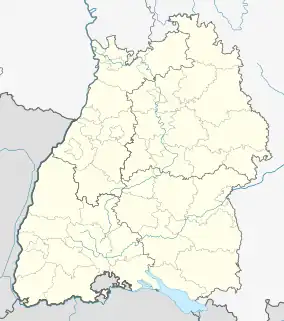Langenburg
Langenburg (German pronunciation: [ˈlaŋənbʊɐ̯k]) is a town in the district of Schwäbisch Hall, in Baden-Württemberg, Germany. It is located on a hill above the river Jagst, 18 km northeast of Schwäbisch Hall. It is also the place where Wibele - small, sweet, biscuit-like pastries - were invented and are still baked today.
Langenburg | |
|---|---|
 Langenburg with the Langenburg Castle in the foreground | |
 Coat of arms | |
Location of Langenburg within Schwäbisch Hall district  | |
 Langenburg  Langenburg | |
| Coordinates: 49°15′12″N 09°50′55″E | |
| Country | Germany |
| State | Baden-Württemberg |
| Admin. region | Stuttgart |
| District | Schwäbisch Hall |
| Government | |
| • Mayor (2018–26) | Wolfgang Class[1] |
| Area | |
| • Total | 31.40 km2 (12.12 sq mi) |
| Elevation | 439 m (1,440 ft) |
| Population (2021-12-31)[2] | |
| • Total | 1,934 |
| • Density | 62/km2 (160/sq mi) |
| Time zone | UTC+01:00 (CET) |
| • Summer (DST) | UTC+02:00 (CEST) |
| Postal codes | 74595 |
| Dialling codes | 07905 |
| Vehicle registration | SHA |
| Website | www.langenburg.de |
History
The history of Langenburg begins with the building of a castle on the western hill crag. Prehistoric settling is likely, but not proven. Langenburg is first documented in 1226. The free Lords of Langenburg, which stepped into history in 1201, were closely related to the Lords of Hohenlohe. Maybe they even held family bonds. After the Langenburgs had died out, the Hohenlohe family inherited the possessions. Langenburg thus came under the rule of Hohenlohe and remained part of the Principality for the next centuries. Since 1568 Langenburg was the residency of the county and latter principality Hohenlohe-Langenburg.
In the 17th century, Langenburg was the site of witch trials. The last victims, Anna Schmieg and Barbara Schleicher, were executed in 1672.
Sights
Langenburg has a vintage car museum and the large Langenburg Castle, the seat of the family of Hohenlohe-Langenburg. The current owner of the castle and estate is Philipp, Prince of Hohenlohe-Langenburg.
People
- Philip Ernest, Count of Hohenlohe-Langenburg (1584-1628), landowner, Count of Hohenlohe-Langenburg
- Henry Frederick, Count of Hohenlohe-Langenburg (1625-1699), landowner, Count of Hohenlohe-Langenburg
- Albert Wolfgang, Count of Hohenlohe-Langenburg (1659-1715), landowner, Count of Hohenlohe-Langenburg
- Ludwig, Prince of Hohenlohe-Langenburg (1696-1765), landowner, 1st Prince of Hohenlohe-Langenburg
- Christian Albrecht, Prince of Hohenlohe-Langenburg (1726-1789), landowner, 2nd Prince of Hohenlohe-Langenburg
- Karl Ludwig, Prince of Hohenlohe-Langenburg (1762-1825), landowner, 3rd Prince of Hohenlohe-Langenburg
- Ernst I, Prince of Hohenlohe-Langenburg (1794-1860), landowner, 4th Prince of Hohenlohe-Langenburg
- Viktor I, Duke of Ratibor (1818-1893), landowner and politician
- Carl Ludwig II, Prince of Hohenlohe-Langenburg (1829-1907), landowner and politician, 5th Prince of Hohenlohe-Langenburg
- Hermann, Prince of Hohenlohe-Langenburg (1832-1913), landowner and politician, 6th Prince of Hohenlohe-Langenburg
- Ernst II, Prince of Hohenlohe-Langenburg (1863-1950), landowner and politician, 7th Prince of Hohenlohe-Langenburg
- Gottfried, Prince of Hohenlohe-Langenburg (1897-1960), landowner, 8th Prince of Hohenlohe-Langenburg
Gallery
 Langenburg in 1656
Langenburg in 1656 Langenburg Castle
Langenburg Castle Castle museum
Castle museum
Bibliography
- Robisheaux, Thomas (2009). The Last Witch of Langenburg: Murder in a German Village. W.W. Norton & Co. ISBN 978-0-393-06551-0.
References
- Aktuelle Wahlergebnisse, Staatsanzeiger, accessed 15 September 2021.
- "Bevölkerung nach Nationalität und Geschlecht am 31. Dezember 2021" [Population by nationality and sex as of December 31, 2021] (CSV) (in German). Statistisches Landesamt Baden-Württemberg. June 2022.